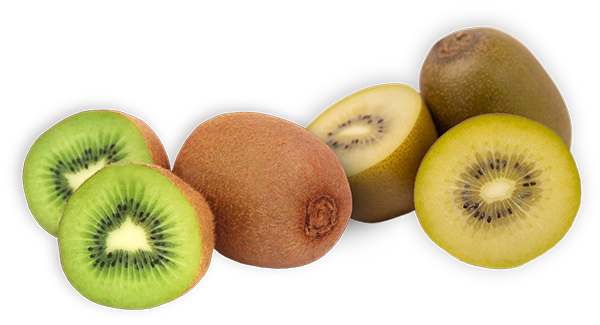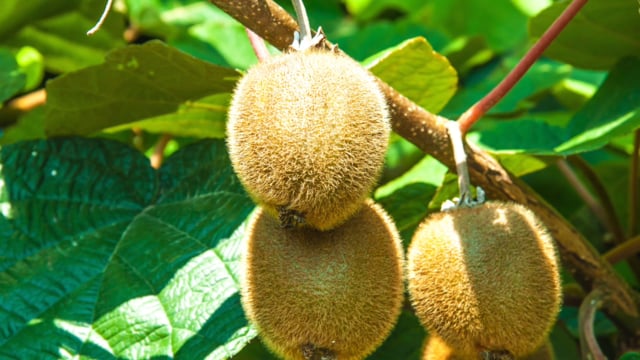Kiwi Fruit Fun Facts: Can It Help You Sleep?
- By Erin Mittelstaedt
- Reading Time: 3 mins.
One moment I’m sitting at my kitchen table with my laptop, fingers hovering over the keys, itching to type up this week’s Chief Banana email. The next, my head snaps up, and I realize that my neck is sore from hanging forward for too long. I’ve just fallen asleep at my computer!
As the head of a fruit company, that made me wonder—can fruit affect our sleep?

The Connection Between Kiwi and Sleep
This tiny study on kiwis found that eating them could make a difference in how well we sleep. The study is quite small (only 24 people) so more research is needed, but participants who ate two kiwis an hour before bedtime for four weeks had higher sleep quality scores than those who didn’t.

It probably wouldn’t hurt for me to add more kiwi to my bedtime routine, because I’m pretty sure my mid-email nap happened after a few nights of low-quality sleep in a row. (Going to bed too late might have had something to do with it, too.) Whether they truly help with sleep or not, I’m happy to celebrate these fuzzy fruits. Here are a few fun kiwi fruit fun facts that every fruit lover should know.
Kiwi Fruit Fun Facts
Two of the most common kiwi varieties are the green Hayward kiwi and the gold or yellow SunGold kiwi. Although both kinds of kiwis are Vitamin C powerhouses, the SunGold kiwi contains 161.3 milligrams of Vitamin C per 100 grams—that’s almost three times the amount found in oranges and strawberries. Kiwis are also a great source of fiber, potassium, Vitamin E, and folate, and they’re helpful for digestion.

As you may know, you can also eat the peel of the kiwi. I’m not a big fan of the furry green kiwi peel (I don’t usually eat it), but the gold kiwi peel is smoother, thinner, and a lot more enticing. Before you dig in, just keep in mind that many people with latex allergies are also allergic to kiwi, because some of the proteins in kiwi are similar to those in latex. Symptoms can vary but may include an itchy mouth or rash.
Whether you eat the peels or not, enjoying kiwis is a great way to boost your immune system, aid your gut, and (apparently, possibly) improve your sleep. I just might try it myself.
Kiwi Fruit FAQs
1. How do you eat a kiwi?
You can eat kiwi fruit out of hand, skin and all, or cut it in half and scoop out the flesh with a spoon. We call that the two-cup method—watch our video to see how it’s done.
2. Can you eat kiwi skin?
Yes! Like I mentioned above, kiwis have edible peels. Green kiwi peels tend to be fuzzier than their gold or yellow cousins.
3. What’s the difference between gold kiwi and green kiwi?
Gold kiwi has smooth skin, golden or yellow flesh, and a sweet, tropical taste. Green kiwi has fuzzy skin, green flesh, and a milder sweet flavor.
4. Where do kiwi come from?
Historians have traced the kiwi back to China, and it was originally called the Chinese gooseberry. Kiwi spread to New Zealand in the 1900s. That’s where it got the name we use today!
5. Can people be allergic to kiwi?
Yes, some people have kiwi allergies. Many people with latex allergies are actually allergic to kiwi, because kiwi and latex have some proteins in common. You might be allergic to kiwi if you develop an itchy mouth or rash after eating it.
6. Can dogs eat kiwi?
I’m not a veterinarian, but I did a bit of research and found that multiple vets agree kiwi is safe for dogs in small amounts. If you want to give your pup kiwi as a treat, remove the skin and only offer a slice. Then, keep an eye on your dog to make sure they’re okay. Some dogs may have allergies to kiwi or be sensitive to new foods.
Welcome to the Chief Banana newsletter—weekly letters from the desk of The FruitGuys’ CEO. Find more Chief Banana newsletters here. To get Chief Banana in your inbox every week, fill out the “Subscribe to our Newsletter” form on this page.


